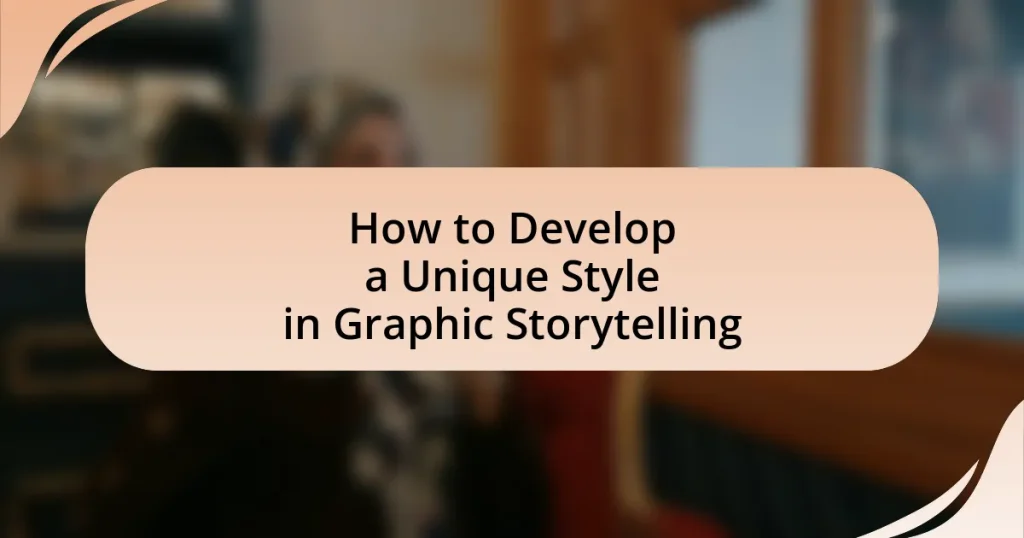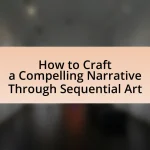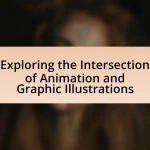The article focuses on developing a unique style in graphic storytelling, emphasizing the importance of distinctive visual and narrative techniques that artists use to convey their stories. It explores how elements such as character design, color palettes, composition, and typography contribute to a recognizable artistic voice, enhancing audience engagement and emotional impact. Additionally, the article outlines practical steps for identifying and refining one’s unique style, including self-reflection, experimentation, and seeking feedback, while also discussing common pitfalls to avoid. Overall, it provides a comprehensive guide for graphic storytellers aiming to differentiate their work in a competitive market.
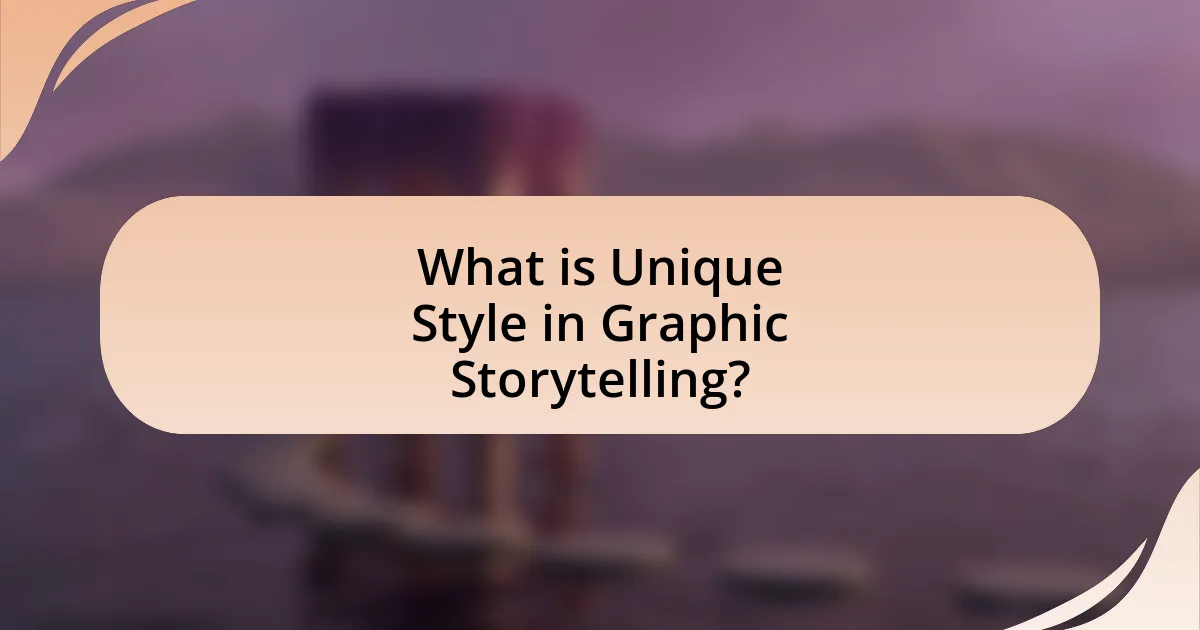
What is Unique Style in Graphic Storytelling?
Unique style in graphic storytelling refers to the distinctive visual and narrative techniques that an artist employs to convey their story. This style encompasses elements such as character design, color palette, composition, and the integration of text and imagery, which together create a recognizable and personal artistic voice. For instance, artists like Chris Ware and Marjane Satrapi have developed unique styles that reflect their individual perspectives and cultural backgrounds, enhancing the emotional impact and thematic depth of their narratives.
How does a unique style influence storytelling in graphics?
A unique style significantly influences storytelling in graphics by establishing a distinct visual language that enhances narrative engagement. This visual language can evoke specific emotions, set the tone, and create a memorable identity for the story. For instance, the use of vibrant colors and exaggerated forms in graphic novels like “Scott Pilgrim” by Bryan Lee O’Malley amplifies the comedic and energetic aspects of the narrative, making it more relatable and immersive for readers. Additionally, unique styles can differentiate a work within a crowded market, as seen with the minimalist approach in “The Arrival” by Shaun Tan, which uses sparse visuals to convey complex themes of immigration and belonging without relying on text. Thus, a unique style not only shapes the aesthetic experience but also deepens the audience’s connection to the story being told.
What elements contribute to a unique graphic storytelling style?
A unique graphic storytelling style is primarily shaped by visual elements, narrative structure, and character design. Visual elements include the use of color palettes, line quality, and composition, which can evoke specific emotions and set the tone of the story. Narrative structure refers to the way the story is organized, including pacing, panel layout, and the integration of text and imagery, which can create a distinctive flow and engagement for the reader. Character design encompasses the visual representation and development of characters, influencing how audiences connect with them and perceive their journeys. These elements collectively contribute to a graphic storytelling style that stands out, as evidenced by successful works like “Maus” by Art Spiegelman, which utilizes a unique combination of these factors to convey complex themes through its distinctive visual and narrative approach.
How does visual language shape the narrative in graphic storytelling?
Visual language shapes the narrative in graphic storytelling by conveying emotions, actions, and themes through imagery, color, and composition. This non-verbal communication allows readers to interpret the story’s context and emotional depth without relying solely on text. For instance, the use of contrasting colors can signify conflict or tension, while specific visual styles, such as minimalism or realism, can influence the audience’s perception of the narrative’s tone. Research indicates that visual elements can enhance memory retention and engagement, making the storytelling experience more impactful.
Why is developing a unique style important for graphic storytellers?
Developing a unique style is crucial for graphic storytellers because it distinguishes their work in a saturated market. A distinctive style enhances recognition, allowing audiences to identify and connect with the storyteller’s narratives more easily. For instance, renowned graphic novelists like Art Spiegelman and Alison Bechdel have established unique visual languages that not only reflect their personal experiences but also resonate with specific themes, making their stories memorable and impactful. This differentiation is essential for building a loyal audience and establishing a lasting career in the competitive field of graphic storytelling.
What advantages does a unique style provide in a competitive market?
A unique style provides significant advantages in a competitive market by differentiating a brand or creator from others, thereby attracting a specific audience. This differentiation can lead to increased brand recognition, as consumers are more likely to remember and engage with a distinct visual identity. For instance, brands like Apple and Coca-Cola have successfully utilized unique styles to create strong emotional connections with their customers, resulting in higher loyalty and sales. Additionally, a unique style can enhance perceived value, allowing creators to command premium pricing for their work, as seen in the art and fashion industries where originality is highly valued.
How can a unique style enhance audience engagement?
A unique style enhances audience engagement by creating a distinct visual identity that captures attention and fosters emotional connections. This distinctiveness allows creators to stand out in a saturated market, making their work more memorable. Research indicates that visual storytelling, particularly with a unique style, can increase viewer retention by up to 65%, as audiences are more likely to remember content that is visually appealing and different from the norm. Furthermore, a unique style can evoke specific emotions and resonate with target demographics, leading to deeper engagement and interaction with the content.
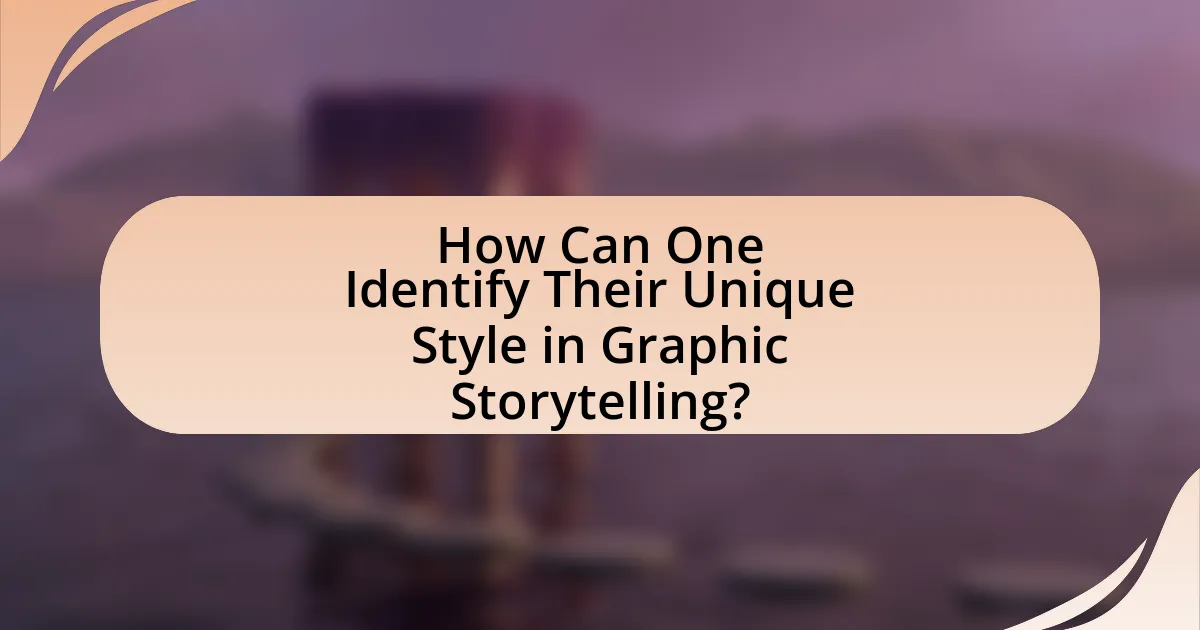
How Can One Identify Their Unique Style in Graphic Storytelling?
To identify a unique style in graphic storytelling, one should analyze personal influences, experiment with various techniques, and seek feedback. Personal influences include favorite artists, genres, and themes that resonate, which can guide stylistic choices. Experimentation with different mediums, color palettes, and narrative structures allows for the discovery of what feels authentic. Seeking feedback from peers or mentors can provide insights into strengths and areas for improvement, helping to refine and define a distinctive style. This process is supported by the understanding that many successful graphic storytellers, such as Art Spiegelman and Alison Bechdel, have developed their unique styles through similar methods of exploration and reflection.
What steps can be taken to discover personal artistic influences?
To discover personal artistic influences, individuals should engage in self-reflection and exploration of various art forms. This involves analyzing personal preferences by creating a mood board that includes artworks, styles, and artists that resonate emotionally. Additionally, studying the works of diverse artists across different mediums can provide insights into varying techniques and themes. Attending art exhibitions, workshops, and discussions can further expose individuals to new ideas and perspectives. Keeping a journal to document thoughts and reactions to different artworks can help clarify which influences are most impactful. Research indicates that exposure to a wide range of artistic expressions enhances creativity and helps in identifying personal style (Csikszentmihalyi, 1996).
How can analyzing favorite graphic works help in style development?
Analyzing favorite graphic works aids in style development by allowing artists to identify and understand the elements that resonate with them. This process involves examining aspects such as color palettes, composition, line work, and thematic choices, which can inform an artist’s own creative decisions. Research indicates that artists who study works they admire can better articulate their preferences and incorporate similar techniques into their own style, leading to a more defined artistic voice. For instance, a study published in the Journal of Visual Arts Research highlights that artists who engage in critical analysis of admired works often experience enhanced creativity and innovation in their own projects.
What role does self-reflection play in identifying one’s style?
Self-reflection is crucial in identifying one’s style as it allows individuals to analyze their preferences, influences, and creative choices. Through self-reflection, artists can assess their past works, recognize patterns, and understand what resonates with them emotionally and aesthetically. This process leads to a clearer articulation of their unique voice and visual language. Research indicates that self-reflection enhances creative development by fostering greater self-awareness, which is essential for personal expression in graphic storytelling.
How can experimentation lead to a unique graphic storytelling style?
Experimentation can lead to a unique graphic storytelling style by allowing creators to explore diverse techniques, materials, and narratives that differentiate their work. By engaging in various artistic methods, such as mixing traditional and digital media or employing unconventional layouts, artists can discover new visual languages that resonate with their personal voice. Historical examples, like the use of collage in graphic novels by artists such as Art Spiegelman in “Maus,” demonstrate how innovative approaches can redefine storytelling aesthetics and engage audiences in novel ways. This process of trial and error fosters originality, enabling creators to carve out distinctive identities in the graphic storytelling landscape.
What techniques can be used to experiment with different styles?
Techniques to experiment with different styles in graphic storytelling include using varied color palettes, altering line weights, and incorporating diverse artistic mediums. For instance, artists can explore digital tools to create vibrant color schemes or utilize traditional materials like ink and watercolor to achieve distinct textures. Research indicates that experimenting with these elements can lead to innovative visual narratives, as seen in the works of artists like David Mack, who blends different styles to enhance storytelling.
How does feedback from peers influence style experimentation?
Feedback from peers significantly influences style experimentation by providing diverse perspectives that can validate or challenge an individual’s creative choices. When creators receive constructive criticism or encouragement from peers, it can lead to a deeper exploration of different styles, as they may feel more confident to take risks or refine their techniques. Research indicates that collaborative environments foster innovation; for instance, a study published in the Journal of Creative Behavior found that peer feedback enhances creative output by 30%. This demonstrates that peer interactions not only motivate individuals to experiment with their style but also improve the overall quality of their work through iterative refinement.
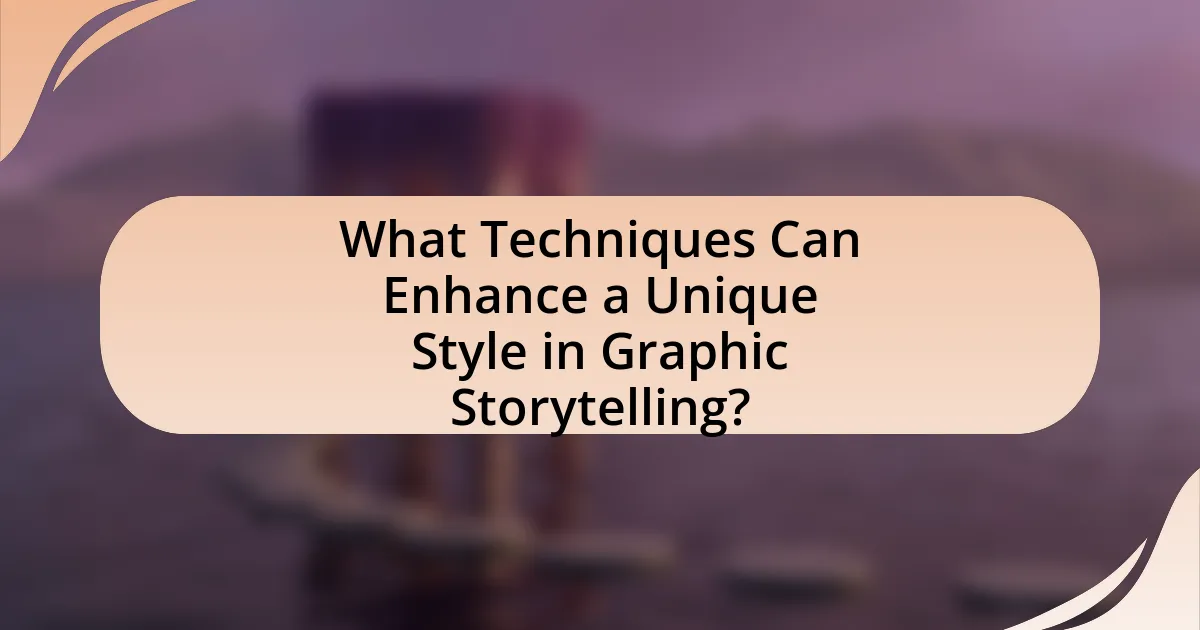
What Techniques Can Enhance a Unique Style in Graphic Storytelling?
Techniques that can enhance a unique style in graphic storytelling include the use of distinctive color palettes, innovative panel layouts, and personalized character design. Distinctive color palettes can evoke specific emotions and set the tone of the narrative, as seen in works like “Saga” by Brian K. Vaughan, where colors reflect the story’s mood. Innovative panel layouts can create dynamic pacing and visual interest, exemplified by “Watchmen” by Alan Moore, which uses varied grid structures to enhance storytelling. Personalized character design, which reflects the personality and background of characters, can make them more relatable and memorable, as demonstrated in “Scott Pilgrim” by Bryan Lee O’Malley, where each character’s design is unique and expressive. These techniques collectively contribute to a graphic storyteller’s unique style, making their work stand out in the medium.
How can color theory be applied to develop a unique style?
Color theory can be applied to develop a unique style by strategically selecting color palettes that evoke specific emotions and enhance storytelling. By understanding the psychological impact of colors, artists can create a distinctive visual language that resonates with their audience. For instance, using complementary colors can create visual tension, while analogous colors can produce harmony. Historical examples, such as the use of bold colors in Expressionism, demonstrate how color choices can define an artist’s style and narrative approach. Additionally, studies show that color can influence viewer perception and engagement, making it a crucial element in graphic storytelling.
What are the psychological effects of color choices in storytelling?
Color choices in storytelling significantly influence the audience’s emotional responses and perceptions. For instance, warm colors like red and orange can evoke feelings of excitement or urgency, while cool colors such as blue and green often promote calmness and tranquility. Research indicates that colors can affect mood and behavior; for example, a study published in the journal “Color Research and Application” by Andrew Elliot and Markus Maier found that red can enhance attention to detail, while blue can foster creativity. These psychological effects of color are crucial in graphic storytelling, as they help convey themes, set the tone, and enhance character development, ultimately guiding the viewer’s emotional journey through the narrative.
How can color palettes be effectively used to convey mood?
Color palettes can be effectively used to convey mood by strategically selecting colors that evoke specific emotional responses. For instance, warm colors like red and orange can create feelings of excitement or warmth, while cool colors such as blue and green often evoke calmness or sadness. Research in color psychology supports this, indicating that colors can significantly influence human emotions and perceptions. A study by Andrew Elliot and Markus Maier published in the journal “Emotion” demonstrates that red can enhance feelings of passion and energy, while blue can promote tranquility and trust. By understanding these associations, artists and designers can choose color combinations that align with the desired mood of their graphic storytelling, enhancing the overall narrative experience.
What role does typography play in establishing a unique style?
Typography plays a crucial role in establishing a unique style by influencing the visual identity and emotional tone of graphic storytelling. The choice of typeface, size, spacing, and arrangement can convey specific moods and themes, thereby enhancing the narrative. For instance, a bold, sans-serif font may evoke modernity and strength, while a delicate, serif font can suggest tradition and elegance. Research indicates that typography significantly affects readability and audience perception, with studies showing that well-chosen typography can increase engagement by up to 30%. This demonstrates that effective typography not only differentiates a style but also enhances the overall storytelling experience.
How can font selection impact the tone of graphic storytelling?
Font selection significantly impacts the tone of graphic storytelling by influencing the emotional response and perception of the narrative. Different fonts convey distinct moods; for instance, serif fonts often evoke a sense of tradition and reliability, while sans-serif fonts can suggest modernity and simplicity. Research indicates that typeface choices can alter readers’ interpretations of characters and settings, as demonstrated in a study by McGurk and MacDonald (2018), which found that participants associated specific fonts with particular personality traits. Thus, the careful selection of fonts is crucial in shaping the overall tone and enhancing the storytelling experience.
What are the best practices for integrating typography with visuals?
The best practices for integrating typography with visuals include ensuring readability, maintaining visual hierarchy, and creating harmony between text and imagery. Readability is achieved by selecting appropriate font sizes and styles that are legible against the background. Visual hierarchy can be established through the use of contrast, size, and placement, guiding the viewer’s attention effectively. Harmony is created by choosing typefaces that complement the visual elements, ensuring that both text and images work together cohesively. These practices enhance the overall aesthetic and communicative effectiveness of graphic storytelling.
What are some common pitfalls to avoid when developing a unique style?
Common pitfalls to avoid when developing a unique style in graphic storytelling include imitating others, neglecting personal voice, and overcomplicating designs. Imitating others can lead to a lack of originality, making it difficult to stand out in a saturated market. Neglecting personal voice results in a style that may not resonate with the creator’s true identity, ultimately diminishing authenticity. Overcomplicating designs can overwhelm the audience, detracting from the story’s core message. These pitfalls hinder the development of a distinctive and effective graphic storytelling style.
How can overcomplicating designs detract from storytelling?
Overcomplicating designs can detract from storytelling by obscuring the narrative and overwhelming the audience. When visual elements are excessively intricate, they can distract viewers from the core message, making it difficult for them to engage with the story. Research indicates that simplicity in design enhances comprehension and retention; for instance, studies show that audiences are more likely to remember information presented in a clear and straightforward manner. Therefore, maintaining a balance between visual appeal and narrative clarity is essential for effective storytelling in graphic mediums.
What are the risks of imitating other artists’ styles?
Imitating other artists’ styles poses several risks, including the potential for copyright infringement, lack of originality, and stunted artistic growth. Copyright infringement can occur if the imitation is too close to the original work, leading to legal consequences. Lack of originality may result in the artist being perceived as uncreative or derivative, which can hinder their reputation and marketability. Additionally, relying on another artist’s style can prevent the development of one’s unique voice, ultimately limiting the artist’s ability to innovate and express personal ideas. These risks highlight the importance of cultivating an individual style in graphic storytelling to ensure both legal safety and personal artistic fulfillment.
What practical tips can help in developing a unique style in graphic storytelling?
To develop a unique style in graphic storytelling, artists should focus on experimenting with various techniques, such as different color palettes, line weights, and narrative structures. This experimentation allows creators to discover what resonates with their personal vision and audience. For instance, using a limited color palette can create a distinct mood and enhance storytelling, as seen in works like “Sin City” by Frank Miller, where the stark contrast emphasizes the narrative’s tone. Additionally, studying diverse influences, from classic comics to contemporary graphic novels, can inspire originality and innovation in style. Engaging in regular practice and seeking feedback from peers can further refine an artist’s unique voice, ensuring that their storytelling remains both personal and impactful.
How can regular practice and consistency contribute to style development?
Regular practice and consistency significantly enhance style development by allowing individuals to refine their techniques and explore their creative voice. Engaging in consistent practice enables artists to experiment with various styles, leading to a deeper understanding of their preferences and strengths. For instance, a study published in the journal “Psychology of Aesthetics, Creativity, and the Arts” by Silvia and Nusbaum (2011) found that regular engagement in creative activities fosters skill improvement and personal style evolution. This evidence supports the notion that dedicated practice not only hones technical abilities but also encourages the discovery of a unique artistic identity over time.
What resources are available for learning and inspiration in graphic storytelling?
Resources available for learning and inspiration in graphic storytelling include books, online courses, workshops, and communities. Notable books such as “Understanding Comics” by Scott McCloud provide foundational knowledge on the medium, while online platforms like Skillshare and Coursera offer structured courses on graphic storytelling techniques. Workshops, often hosted by local art schools or conventions, allow for hands-on experience and feedback from professionals. Additionally, online communities such as DeviantArt and Behance serve as platforms for sharing work and gaining inspiration from peers. These resources collectively support the development of a unique style in graphic storytelling by providing both theoretical knowledge and practical application opportunities.
